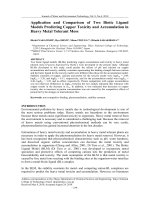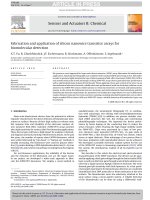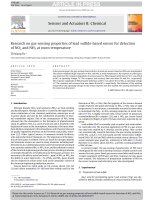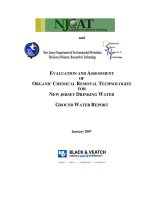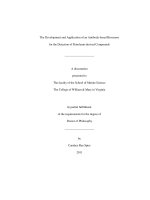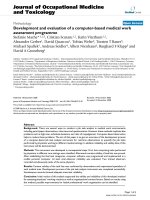Performance and evaluation of various radiation based models for semi-arid region
Bạn đang xem bản rút gọn của tài liệu. Xem và tải ngay bản đầy đủ của tài liệu tại đây (412.58 KB, 12 trang )
Int.J.Curr.Microbiol.App.Sci (2019) 8(4): 2108-2119
International Journal of Current Microbiology and Applied Sciences
ISSN: 2319-7706 Volume 8 Number 04 (2019)
Journal homepage:
Original Research Article
/>
Performance and Evaluation of Various Radiation
Based Models for Semi-arid Region
Yadvendra Pal Singh*, H.K. Mittal, Vinay Kumar Gautam and Jalgaonkar Bhagyashri
Departmant of Soil &Water Engineering, Maharana Pratap University of Agriculture and
Technology, Udaipur, India
*Corresponding author
ABSTRACT
Keywords
Radiation models,
Solar radiation
Article Info
Accepted:
15 March 2019
Available Online:
10 April 2019
This study aimed to Performance of seven radiation models. The objective was to
determine the most accurate model for estimating solar radiation. Performance and
Evaluation of all the models on the same basis is prerequisite for selecting an alternative
approach in accordance with available data such as air temperature (Tmax, Tmin, Tmean),
actual sunshine hours (n), Relative Humidity (Rhmax, Rhmin & RHmean) and potential
sunshine hours (N). Therefore, recommended Angstrom-Prescott (A-P) model locally
calibrated A-P model, Dogniaux-Lemoine (D-L) model, Glower-Meculloch model,
Hargreaves-Samani model (1985),Chen et al. (2004), Ertekin and Yaldiz (1999) and
Almorox - Hontoria (2004) radiation based model were used to estimate monthly solar
radiation (Rs) at Udaipur(Rajasthan), India. Further, the performance of all these methods
were evaluated by regression and error analysis between standard Rs derived using FAO
recommended Angstrom-Prescott (A-P) model and Rs values estimated using all the six
models, on monthly basis. On monthly basis, Glower-Meculloch model performed best
with highest coefficient of determination (1.00) and lowest Root mean square error
(0.9089) MJ m−2 day−1. Based on overall results it was concluded that the radiation based
model provides average monthly accurate estimate of solar radiation compared to other
models.
Introduction
Almost all of the energy that drives the
various
systems
(climate
systems,
ecosystems, hydrologic systems, etc.) found
on the Earth originates from the sun. Solar
energy is created at the core of the sun when
hydrogen atoms are fused into helium by
nuclear fusion. The core occupies an area
from the sun’s centre to about a quarter of the
star’s radius. At the core, gravity pulls all of
the mass of the sun inward and creates intense
pressure. This pressure is high enough to
force the fusion of atomic masses. For each
second of the solar nuclear fusion process,
700 million tons of hydrogen is converted into
the heavier atom helium. Since its formation
4.5 billion years ago, the sun has used up
about half of the hydrogen found in its core.
The solar nuclear process also creates
immense heat that causes atoms to discharge
photons. Temperatures at the core are about
15 million degrees Kelvin (27 million degrees
F). Each photon that is created travels about
2108
Int.J.Curr.Microbiol.App.Sci (2019) 8(4): 2108-2119
one micrometer before being absorbed by an
adjacent gas molecule. This absorption then
causes the heating of the neigh boring atom
and it re-emits another photon that again
travels a short distance before being absorbed
by another atom. This process then repeats
itself many times over before the photon can
finally be emitted to outer space at the sun’s
surface. The last 20% of the journey to the
surface the energy is transported more by
convection than by radiation. It takes a photon
approximately 100,000 years or about 1025
absorptions and re-emissions to make the
journey from the core to the sun’s surface.
The trip from the sun’s surface to the Earth
takes about 8 minutes.
The irradiative surface of the sun, or
photosphere, has an average temperature of
about 5,800 Kelvin. Most of the
electromagnetic emitted from the sun's
surface lies in the visible band cantered at 500
nm (1 nm = 10-9meters), although the sun
also emits significant energy in the ultraviolet
and infrared bands, and small amounts of
energy in the radio, microwave, X-ray and
gamma ray bands. The total quantity of
energy emitted from the sun's surface is
approximately 63,000,000 Watts per square
meter (W/m2 or Wm-2). The energy emitted
by the sun passes through space until it is
intercepted by planets, other celestial objects,
or interstellar gas and dust. The intensity of
solar radiation striking these objects is
determined by a physical law known as the
Inverse Square Law. This law merely states
that the intensity of the radiation emitted from
the sun varies with the squared distance from
the source. As a result of this law, if the
intensity of radiation at a given distance is
one unit, at twice the distance the intensity
will become only one-quarter. At three times
the distance, the intensity will become only
one- ninth of its original intensity at a
distance of one unit, and so on.
Solar radiation
Solar radiation is radiant energy emitted by
the sun, particularly electromagnetic energy.
About half of the radiation is in the visible
short-wave part of the electromagnetic
spectrum. The other half is mostly in the nearinfrared part, with some in the ultraviolet part
of the spectrum. The amount of energy
radiated by the sun and the average Earth-sun
distance of 149.5 million kilometres, the
amount of radiation intercepted by the outer
limits of the atmosphere can be calculated to
be around 1,367 W/m2. Only about 40% of
the solar energy intercepted at the top of
Earth's atmosphere passes through to the
surface. The atmosphere reflects and scatters
some of the received visible radiation.
Gamma rays, X-rays, and ultraviolet radiation
less than 200 nanometres in wavelength are
selectively absorbed in the atmosphere by
oxygen and nitrogen and turned into heat
energy. Most of the solar ultraviolet radiation
with a range of wavelengths from 200 to 300
nm is absorbed by the concentration of ozone
(O3) gas found in the stratosphere. Infrared
solar radiation with wavelengths greater than
700 nm is partially absorbed by carbon
dioxide, ozone, and water present in the
atmosphere in liquid and vapour forms.
Roughly 30% of the sun's visible radiation
(wavelengths from 400 nm to 700 nm) is
reflected back to space by the atmosphere or
the Earth's surface. The reflectivity of the
Earth or and body is referred to as its albedo,
defined as the ratio of light reflected to the
light received from a source, expressed as a
number between zero (total absorption) and
one (total reflectance).
Knowledge of the local global solar radiation
is required by most models that simulate crop
growth, and is also essential for many
applications, including evapotranspiration
estimates, architectural design, and solar
energy systems. Design of a solar energy
2109
Int.J.Curr.Microbiol.App.Sci (2019) 8(4): 2108-2119
conversion
system
requires
precise
knowledge regarding the availability of global
solar radiation at the location of interest.
Since the global solar radiation reaching the
earth’s surface depends upon the local
meteorological conditions, a study of solar
radiation under local climatic conditions is
Essential. Solar irradiance can be estimated
using empirical models (Almorox, 2011).
Therefore, various methods have been
explored by many researchers to estimate,
with reasonable accuracy, the solar radiation
from other available meteorological data.
Parameters used as inputs in the relationships
include astronomical factors (solar constant,
world-sun distance, solar declination and hour
angle); geographical factors (latitude,
longitude and altitude); geometrical factors
(surface azimuth, surface tilt angle, solar
altitude, solar azimuth); physical factors
(albedo, scattering of air molecules, water
vapour content, scattering of dust and other
atmospheric constituents); and meteorological
factors (atmospheric pressure, cloudiness,
temperature,
sunshine
duration,
air
temperature, soil temperature, relative
humidity, evaporation, precipitation, number
of rainy days, total perceptible water, etc).
Total daily solar radiation is considered as the
most important parameter in the performance
prediction of renewable energy systems,
particularly in sizing photovoltaic (PV) power
systems, agriculture and building design
applications (Sabziparvar and Shetaee, 2007).
Solar radiation arriving on earth is the most
fundamental renewable energy source in
nature. a reasonably accurate knowledge of
the availability of the solar resource at any
place is required by solar engineers,
architects, agriculturists, and hydrologists for
many applications of solar energy such as
solar furnaces, concentrating collectors, and
interior illumination of buildings. In spite of
the
importance
of
solar
radiation
measurements, this information is not readily
available due to cost, maintenance, and
calibration requirements of the measuring
equipment (Bakirci, 2009).
A good knowledge of solar radiation is
essential for many applications, including
agricultural, ecological, hydrological and
soil–vegetation–atmosphere transfer models
(Liu et al., 2009). Despite its significance,
accurate long-term records of solar radiation
are not widely available due to the cost of
measuring equipment and its difficult
maintenance and calibration (Hunt et al.,
1998).
Solar energy is the most abundant renewable
and sustainable energy source on earth. Due
to the nature of solar energy which is
inexhaustible and ubiquitous, it can be
utilized extensively as an appropriate option
to supply the worldwide energy demand and
diminish the existing environmental problems
such as climate change. Thus, the growth of
solar energy technology industry has been
significant recently (Gani et al., 2015).
Objectives
Keeping in view the relevance of precise
calculation of solar radiation (Rs) values for
monthly average, present study was taken up
with following major objectives:
1)
2)
To determine monthly average solar
radiation: and
To compare Rs values obtained from
different model with standard model.
Materials and Methods
This chapter encompasses description of
study area, collection and analysis of
metrological data and comparison of solar
radiation by using six different models with
Angstrom-Prescott (A-P) method.
2110
Int.J.Curr.Microbiol.App.Sci (2019) 8(4): 2108-2119
General description of the study area
The study was conducted at Maharana Pratap
University of Agriculture and Technology,
Udaipur (24°N latitude, 73°E longitude, and
582.17 m above m.s.l.) in Rajasthan state of
India which lies in south slope of the Aravalli
Range in Rajasthan. The area has a Sami-arid
sub tropical climate with three distinct
seasons namely, summer (March- June),
monsoon (July- October) and winter season
(November- February).
Data collection and analysis of metrological
data
The study was undertaken to estimated solar
radiation by using six different models and
Angstrom-Prescott (A-P) method. The
metrological data on daily basis for the period
of seven year (1983-1989), consisting of air
temperature (maximum and minimum);
relative humidity (maximum and minimum);
wind speed; duration of actual sunshine hours,
were
collected
from
meteorological
observatory situated in the premises of Crop
Research Centre of the Maharana Pratap
University of Agriculture and Technology,
Udaipur.
is potential sunshine hours (hs), and a (0.25)
and b (0.50) are the empirical A-P
coefficients.
Glower-McCulloch model
Glower and McCulloch (1958) presented the
model below to predict global RS which is
valid for ϕ < 60o:
……. (2)
Where, Rs is solar radiation (MJ m-2 day-1),
Ra is extraterrestrial solar radiation (MJ m-2
day-1), n is actual sunshine hours (ha), and N
is potential sunshine hours (hs).
Dogniaux-Lemoine model
Dogniaux and Lemoine (1983) suggested the
following equation, which takes in to account
the effect of latitude of the site (Φ) as an
additional input
…(3)
Estimation of solar radiation
Where, Rs is solar radiation (MJ m-2 day-1),
Ra is extraterrestrial solar radiation (MJ m-2
day-1), n is actual sunshine hours (ha), and N
is potential sunshine hours (hs).
Angstrom-Prescott (A-P) model
Hargreaves-Samani model
The A-P model was first proposed by
Angstrom in 1924 and further modified by
Prescott in 1940. The A-P formula was
developed based on the linear relationship
between monthly mean daily Rs and sunshine
hours as follows:
According to Hargreaves and Samani (1985),
the difference between the maximum and
minimum temperature is related to the degree
of cloud cover in a given location. Clear-sky
conditions result in high temperatures during
the day (Tmax) because the atmosphere is
transparent to the incoming RS and in low
temperatures during the night (Tmin) because
less outgoing long wave radiation is absorbed
by the atmosphere. On the other hand, in
overcast conditions, Tmax is relatively
smaller because a significant part of the
… (1)
Where, Rs is solar radiation (MJ m-2 day-1),
Ra is extraterrestrial solar radiation (MJ m-2
day-1), n is actual sunshine hours (ha), and N
2111
Int.J.Curr.Microbiol.App.Sci (2019) 8(4): 2108-2119
incoming RS never reaches the earth’s surface
and is absorbed and reflected by the clouds.
Similarly, Tmin will be relatively higher as
the cloud cover acts as a blanket and
decreases the outgoing longwave radiation.
Therefore, the differences between the
maximum and minimum temperature (TmaxTmin) can be used as an indicator of the
fraction of extraterrestrial radiation that
reaches the earth’s surface (Hargreaves and
Samani 1985). The Hargreaves-Samani
formula for estimating RS (MJm-2 day-1) is
as follows:
……. (5)
temperature (ºC).
Almorox-Hontoria model
Almorox and Hontoria (2004) have suggested
an exponential type model as:
…..(8)
Where, Rs is solar radiation (MJ m-2 day-1),
Ra is extraterrestrial solar radiation (MJ m-2
day-1), n is actual sunshine hours (ha), and N
is potential sunshine hours (hs),
Results and Discussion
where Ra is the extraterrestrial radiation
(MJm-2 day-1), Tmax is the maximum air
temperature (ºC), Tmin is the minimum air
temperature (ºC) and RS K is an adjustment
factor which was initially set to 0.17 for arid
and semi-arid regions.
Hargreaves (1994) later recommended values
of 0.16 and 0.19 for inland and coastal
regions, respectively. Daily Ra is given by the
following equation (Allen et al., 1998):
Chen et al., (2004) proposed the following
model:
(6)
where Ra is the extraterrestrial radiation
(MJm-2 day-1), Tmax is the maximum air
temperature (ºC), Tmin is the minimum air
temperature (ºC)
Ertekin and Yaldiz
Ertekin and Yaldiz (1999) reported that RS
can be calculated by the following Equation
……(7)
where Ra is the extraterrestrial radiation
(MJm-2 day-1), Tmean is the mean air
The present study was carried out to
determine solar radiation value for
metrological observatory of Department of
Soil and Water Engineering, College of
Technology Agriculture engineering situated
in Udaipur district of Rajasthan state by using
value of Rs obtained with Angstrom-Prescott
(A-P) model and various radiation based
model to assess performance of various
models for determining the Rs value.
Comparison of Rs value determined by
various model with Angstrom-Prescott (AP) method model on average monthly basis
The data related to comparison between
Observed values and Estimated values
Monthly average daily solar radiation (MJm−2
day−1) for six Models are presented in Table
1.
Daily solar radiation by various equations was
estimated and compared with observed
radiation at the weather station. Figure 1
showed that the values of solar radiation for
Dogniaux-Lemonine
model
were
overestimated from Angstrom-Prescott (A-P)
model for June, July and August by 1.39, 9.16
and 14.61 % respectively and underestimated
for remaining months. The values of solar
2112
Int.J.Curr.Microbiol.App.Sci (2019) 8(4): 2108-2119
radiation for Almonrox-Hontria (2004) model
were underestimated from Angstrom-Prescott
(A-P) model in all months. the GlowerMeculloch model were overestimated from
Angstrom-Prescott (A-P) model for all 12
months by 4.61, 4.61, 4.66, 4.66, 4.67, 4.76,
4.92, 5.04, 4.72, 4.62 and 4.60% respectively.
For Ertekin-Xaldiz (1999) model were
overestimated with observed model in two
month (July and August) by 10.92 and 25.32
and underestimated for remaining months. the
value of solar radiation for Hargreaves-
Samani model were overestimated with
observed model in the six months (January,
February, March, October, November and
December) by 9.00, 4.01, 6.63, 7.34, 11.53
and 15.16 % respectively and underestimated
in all months. the Chen et al., (2004) model
were overestimated from Angstrom-Prescott
(A-P) model for January, February, march,
October, November and December by 5.71 %,
1 %, 3.76%, 4%,7.31%, and 11.19%
respectively
and
underestimated
for
remaining months.
Table.1 The comparison between observed values and estimated values monthly average daily
solar radiation (MJm−2 day−1) for six Models
MODEL
Observes
DogniauxLemonine
AlmonroxHontria
GlowerMeculloch
ErtekinXaldiz
HargreavesSamani
Chen
Jan
15.5072
Feb
19.1096
March
21.3236
April
24.4313
May
25.6978
MONTHS
June
July
23.0783 18.6527
Aug
15.4949
Sept
19.3408
Oct
18.5381
Nov
16.0132
Dec
14.1019
14.6085
17.9606
20.5257
23.5508
24.9440
23.4000
20.3627
17.7590
19.2264
17.4847
14.9593
13.3479
13.0213
16.0814
17.4843
20.0004
20.9046
18.4614
14.8128
12.4836
15.5367
15.5520
13.5707
11.8003
16.2233
19.9913
22.3175
25.5707
26.8999
24.1786
19.5722
16.2763
20.2550
19.3947
16.7502
14.7618
10.7612
13.5958
17.0328
20.1747
21.9487
21.7169
20.7004
19.4176
17.6685
14.4949
11.6891
10.0041
16.9043
19.8761
22.7379
24.3345
23.5234
20.1447
16.0104
14.9601
18.0892
19.9164
17.8601
16.2406
16.3936
19.3020
22.1269
23.7686
23.1301
19.5687
14.5271
13.4661
17.6542
19.2811
17.1845
15.6805
Table.2 Statistical comparison between observed Rs values and those estimated by the
models
Models
R²
GlowerMeculloch
AlmoroxHontria
Dogniaux
H-G
Chen
Ertekin-Xaldiz
1.000
RMSE (MJm−2
day−1)
0.9089
0.989
3.4656
0.908
0.763
0.726
0.561
0.9799
1.5473
1.6624
3.6663
2113
six
Int.J.Curr.Microbiol.App.Sci (2019) 8(4): 2108-2119
Fig.1 Comparison between the Observed and estimated values by various models of solar
radiation
Fig.2 Estimated radiation from Dogniaux-Lemonine model against measured radiation
Fig.3 Estimated radiation from Almonrox-Hontria model against measured radiation
2114
Int.J.Curr.Microbiol.App.Sci (2019) 8(4): 2108-2119
Fig.4 Estimated radiation from Glower-Meculloch model against measured radiation
Fig.5 Estimated radiation from Ertekin- Xaldiz model against measured radiation
Fig.6 Estimated radiation from Chen model against measured radiation
2115
Int.J.Curr.Microbiol.App.Sci (2019) 8(4): 2108-2119
Fig.7 Estimated radiation from Chen et al., (2013) model against measured radiation
Statistics comparison
Summary and conclusion are as follows
The statistical analyses for various radiation
models are presented Table 2. A linear
regression between the Rs values estimated
by six models and the values observed in
weather station is presented for AngstromPrescott (A-P) model. In each section of
figure 2 to 6, the equation of regression line
and coefficient of determination (R2) are
represented. Characteristics of regression line
and the amounts of statistical indices resulting
from comparison are represented also in
Table 2. Table 2 showed that the values of
coefficient of determination and root mean
square error for various model.
The main objective of this study was to
determine value of solar radiation by various
models as suggested by Hargreaves-Samani,
Glower-Meculloch, Chen et al., (2004),
Ertekin and Yaldiz (1999), Almorox and
Hontoria (2004), and Dogniaux-Lemonine in
comparison to that observed by AngstromPrescott (A-P) model on the basis of long
term daily meteorological dataset of 7 year
(1983-1989) recorded at udaipur (24° 35’ N
latitude, 73° 42’E longitude, and 582.17 m
above m.s.l.) in Rajasthan state of india. The
other objective in this study includes,
compareson analysis of monthly average of
Rs values calculated by A-P model and
various models.
The highest R² values were found for GlowerMeculloch model with a value of 1 and lowest
for Ertekin - Yaldiz (1999) model with a
value of 0.561. Similarly the highest RMSE
value was found for Almonrox-Hontria
(2004) model with a value of 3.4656 and
lowest for Glower-Meculloch model with a
value of 0.9089 (Fig. 7).
The result revealed that Glower-Meculloch
model was more accurate method for
calculating solar radiation.
The study was carried out at the Maharana
Pratap University of Agriculture and
Technology, Udaipur (Raj.) situated in
southern region of Rajasthan region having a
semi-arid sub tropical climate.
On monthly basis, average value of Rs
determined by various model analysis varied
from 26.8998 to 10.0409 with maximum
value for the month of may and minimum for
the month of December.
2116
Int.J.Curr.Microbiol.App.Sci (2019) 8(4): 2108-2119
The good correlation was observed between
Rs estimated by models proposed by GlowerMeculloch and Almorox-Hontoria (2004)
Model.
The Glower-Meculloch model was more
accurate method for calculating solar
radiation compared to other various radiation
based models.
References
Ahmed, F., Aqil, Burney. S. M. and Husain,
S. A., 1991. Monthly average daily
global beam and diffuse solar radiation
and its correlation with hours of bright
sunshine
for
Karachi,
Pakistan.
Renewable Energy., 1(1): 115– 118.
Aksoy, B. U., Rusen, S. E. and Akinoglu, B.
G., 2011. A simple correlation to
estimate global solar irradiation on a
horizontal surface using METEOSAT
satellite images Turkish. J. Eng. Env.
Sci., 35: 125 –137.
Álvarez, J., Mitasova, H. and Allen, H. Lee.,
2011. Estimating monthly solar radiation
in south- central chile. Chilean Journal
of Agricultural Research. 71(4).
Almorox, J., 2009. Estimating global solar
radiation from common meteorological
data in Aranjuez. Spain. Turk. J. Phys.,
35: 53 – 64.
Aladenola, O.O., and Madramootoo, C. A.,
2014. Evaluation of solar radiation
estimation methods for reference
Badescu, V and Dumitrescu, A., 2015.
Simple solar radiation modelling for
different cloud types and climatology.
Throe. Appl. Climatol., 124: 141–160.
evapotranspiration estimation in Canada.
Theory Apply Climatol., 118: 377–385.
Benghanem, M., and Mellit., 2013. A
simplified
calibrated
model
for
estimating daily global solar radiation in
Madinah, Saudi Arabia. Theor. Appl.
Climatol., 115: 197–205
Bakirci, Kadir., 2009. Correlations for
estimation of daily global solar radiation
with hours of bright sunshine in Turkey.
Energy., 34: 485–501.
Bannani, F. K, S. T. and A, Ben-Khalifa. A.,
2006. Estimation of monthly average
solar radiation in Libya. Theor. Apply
Climatol., 83: 211–215.
Chen, J., Long. and Li, Guo-Sheng., 2013.
Evaluation of support vector machine
for estimation of solar radiation from
measured meteorological variables.
Theor. Appl. Climatol., 115: 67–638.
Gadiwala, S. M., Usman, A., Akhtar, M. and
Jamil, K., 2.013. Empirical models for
the estimation of global solar radiation
with sunshine hours on horizontal
surface in various cities of pakistan.,
18(9).
Gana, N.N., and Akpootu, D. O., 2013.
Angstrom type empirical correlation for
estimating global solar radiation in
north-eastern Nigeria.
Lke, C. U., 2013. Climatological Effects of
total solar radiation in awake, Nigeria.
IOSR Journal of Applied Physics., 5(2):
51-54.
Irmak, S., Irmak, A., Allen, R. G. and Jones,
J.W., 2003. Solar and net radiationbased equations to estimate reference
evapotranspiration in humid climates.
Journal of Irrigation and Drainage
Engineering., (97): 0733- 9437.
I U. A. and U, U. J., 2011. Performance
assessment of Hargreaves model in
estimating solar radiation in Abuja using
minimum
climatological
data.
International Journal of the Physical
Sciences., 31(6): 7285 – 7290.
Jacobs, J. M., Anderson, M. C., Friess, L. C.
and Diak,G. R., 2004. Solar radiation,
long wave radiation and emergent
wetland evapotranspiration estimates
from satellite data in Florida, USA.
Hydrological
Sciences–
Journal–
desSciences Hydrologiques., 49(3).
Li, H., Cao, F., Bu, X. And Zhao, l., 2014.
2117
Int.J.Curr.Microbiol.App.Sci (2019) 8(4): 2108-2119
Models for calculating daily global solar
radiation from air temperature in humid
regions
a
case
study.
DOI
10.1002/ep.12018.
Lyra, G.B., Zanetti, S. S. and Santos, A. R.,
2015. Estimation of monthly global
solar irradiation using the hargreaves–
samani model and an artificial neural
network for the state of Alagoas in north
eastern Brazil. 10.1007/s00704-0151541-8.
Mubiru, J., B, E., D, U. and F, Senyonga. T.,
2007. Assessing the performance of
global
solar
radiation
empirical
formulations in Kampala, Uganda.
Theor. Appl. Climatol., 87: 179–184.
Muzathik, A. M., Ibrahim, M. Z., Samo, K. B.
and Wan, N. W. B., 2011 Estimation of
global solar irradiation on horizontal and
inclined surfaces based on the horizontal
measurements. Energy., 36: 812–818.
Myers, D. R., 2003. Solar Radiation
modelling and measurements for
renewable energy applications. Data and
Model Quality., CP-560-33620.
Mubiru, J., Karume, K., Majaliwa, M., Banda,
E. J. K. B. and Otiti, T., 2007.
Interpolating
methods
for solar
radiation in Uganda. Theor. Appl.
Climatol., 88: 259–263.
Mghouchi, Y. El., Bouardi, A. El., Choulli, Z.
and Ajzoul, T., 2014. New model to
estimate and evaluate the solar radiation.
International Journal of Sustainable
Built Environment., (3): 225–234
Moradi, I., Mueller, R. and Perez, R., 2014.
Retrieving daily global solar radiation
from routine climate variables. Theor.
Appl. Climatol., 116: 661–669.
Muzathik, M. A., Nik, W. M. B. W., Samo,
K. B. and Ibrahim, M. Z., 2010.
Reference solar radiation year and some
climatology aspects of east coast of west
malaysia. American J. of Engineering
and Applied Sciences., 3(2): 293-299.
Namrata, K., Sharma, S. P. and Saksena, S. B.
L., 2013. Comparison of different
models for estimation of global solar
radiation in Jharkhand (India) Region.
Smart Grid and Renewable Energy., 4:
348-352.
Olmo, F. J., Vida, J., Morons, F., Tovar, J.
and Alados- Arboledas, L., 2001.
Performance
reduction
of
solar
irradiance parametric models due to
limitations in required aerosol data: case
of the CPCR2 model. Theor. Appl.
Climatol., 69: 253-263.
Ouali, K., and Alkama, R. 2014. A new
Model of global solar radiation based on
meteorological data in Bejaia City
(Algeria). Energy Procedia., 50: 670 –
676.
Okonkwo, N, G. and Sc, M., 2014. Estimating
global solar radiation from temperature
date in minna location. European
Scientific Journal., 10(15): 1857 – 7881.
Rivington, M., Bellocchi, G., Matthews, K. B.
and Buchan, K., 2005. Evaluation of
three model estimations of solar
radiation at 24 UK stations. Agricultural
and Forest Meteorology., 132: 228–243.
Riza, D., F. A., Gilani, S. I. H., and Aris,
M.S., 2011. Hourly solar radiation
estimation using ambient temperature
and relative humidity data. International
Journal of Environmental Science and
Development., 3(2).
Sabziparvar, Ali. A. and Farahani, M. M.,
2009. An improved estimation of daily
clear- sky biologically EER from
broadband global solar radiation. Int. J.
Biometeorol., 53: 239–245.
Sabziparvar, Ali. A., Sabziparvar., Mousavi,
R., Marofi, S., Heidari, M., and
Ebrahimi Pak, N. A. 2014. Calibration
of angström-prescott solar radiation
model for more accurate estimation of
reference evapotranspiration in the
absence of observed solar radiation
(AEMS)., 6-7.
Sarkar, N.I., 2016. Estimation of solar
2118
Int.J.Curr.Microbiol.App.Sci (2019) 8(4): 2108-2119
radiation from cloud covers data of
Bangladesh. Renewable., 3: 11.
Samani, Z., 2000. Estimating solar radiation
and evapotranspiration using minimum
climatological data. Journal of Irrigation
and Drainage Engineering., 126 (4):
0733-9437.
Shamim, M., Bray, M., Remesan, R. and Han,
D., 2015. A hybrid modelling approach
for assessing solar radiation. Theor
.Appl. Climatol., 122: 403–420.
Toğrul, I.T., 2009. Estimation of solar
radiation from angstroms coefficients by
using geographical and meteorological
data in bishkek, Kyrgyzstan. Is bilimi ve
Teknigi Dergisi., 29(2): 99-108.
Tabari, H., T, P. H., Willems, P. And
Martinez, C., 2014. Validation and
calibration of solar radiation equations
for
estimating
daily
reference
evapotranspiration at cool semi-arid and
arid locations. Hydrological Sciences
Journal.,
DOI:
10.1080/02626667.2014.947293.
Prem, W.P., and Paz, J. O., 2011. Evaluation
of Various Methods for Estimating
Global Solar Radiation in the
Southeastern United States., DOI:
10.1175/JAMC-D-11- 0141.1.
Xu, C.Y., and Singh, V. P., 2000. Evaluation
and generalization of radiation-based
methods for calculating evaporation.
Hydrol. Process., 14(2): 339-349.
Yakubu, D. and W, M. D., 2012. Relationship
between the global solar radiation and
the sunshine duration in abuja, Nigeria.
Turkish Journal of Physics 27(2):161167.
Zhang, Y.L., Qin, B. Q. and Chen, W. M.,
2004. Analysis of 40 year records of
solar radiation data in Shanghai, Nanjing
and Hangzhou in Eastern China. Theor.
Appl. Climatol., 78: 217–227.
Zamani, M., (2015). Temperature-based
estimation of global solar radiation using
soft computing methodologies. Theor.
Appl. Climatol., doi:10.1007/s00704015-1487-x.
How to cite this article:
Yadvendra pal Singh, H.K. Mittal, Vinay Kumar Gautam and Jalgaonkar Bhagyashri. 2019.
Performance and Evaluation of Various Radiation Based Models for Semi-arid Region.
Int.J.Curr.Microbiol.App.Sci. 8(04): 2108-2119. doi: />
2119
